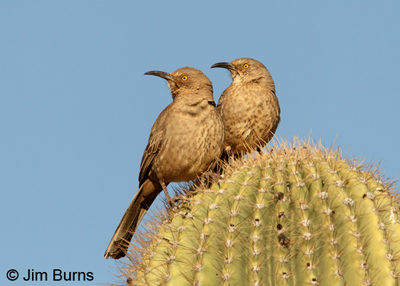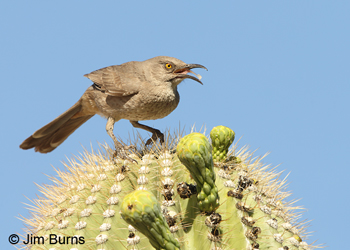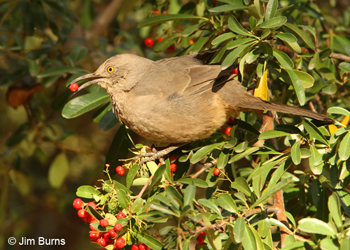
Birders who have feeding stations and water features in their yards often report close and lengthy relationships with their avian neighbors—hummingbirds that get in their face when favorite feeders go dry, quail that visit like clockwork every day while making their neighborhood rounds, wrens that dumpster dive for paper and bright refuse to use in nest building. We have thrashers. The Valley’s common garden variety thrashers, Curve-billeds. But of course they never seem common when you’ve built up a special relationship.
We assume the pair we’ve seen for several years is the same pair. Curve-billed Thrashers are thought to mate for life. We first began to notice them the year they built a nest in our front yard olive tree. Or at least attempted to. We saw the birds bringing small twigs, and one or the other would sit on the framework, perhaps sizing it to suit them, but they never got to the grass lining stage of construction, and seemed to abandon it before eggs were laid. We never detected adults tripping to the area with food items or saw young thrashers in the yard. Perhaps the female decided the olive was not dense enough to hide her preliminary work from prying predator eyes.
The presumed male of the pair is slightly the larger, lengthwise, of the two, and a bit darker, the color of mud in the yard after a good rain. The presumed female seems shorter, a bit plumper, and a lighter, sandier hue. These differences are not discernible unless the pair is seen together, which they are almost daily this time of year.
The thrashers’ year begins in December when the male frequents the front olive to broadcast his warbling, gurgling repertoire from the highest branches, apparently to let his mate know, based on sun angle, temperature, and rainfall, that things are ready to go for another breeding cycle. The song is less repetitive than the local mockingbird’s, and less imitative, and ceases only briefly when we go out the door to retrieve the morning newspaper. Both male and female Curve-billeds are known to sing all of the species’ play list, including the sharp, familiar two syllable “wolf whistle and the soft, velvety whisper song. If you hear the latter, you know they are very close by.
We see them together most days now, either picking through the fallen olives, front and back, or working over the thin strips of dirt in the interstices of our concrete driveway and brick front walkway. The search is on for insects and their larvae, spiders, ants, bits of the olive fruit, and saguaro seeds, and the amount of detritus they leave behind is remarkable and requires a few minutes of broom work every evening.
Yesterday we watched them in back for almost an hour searching through the blanket of olive leaves, noting that after the male had investigated a fallen olive, poked it, rolled it over, taken a bite, then discarded it, the female would follow along and invariably find something of value in the same olive and repeat the entire routine. Very similar, we laugh, to the daily routines of the mated pair watching inside the house.
The thrashers trust us enough now that, when we walk outside during their forays in the yard, they no longer panic and fly off but simply stop what they are doing and watch, gauging our intent and direction before resuming their activity. Any day now we’re anticipating a note from them on the door requesting fresh mealworms.
|
Curve-billed Thrasher in Pyracantha |

